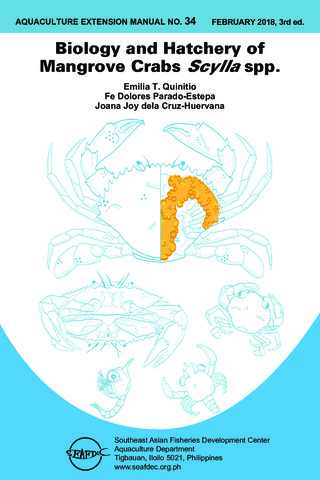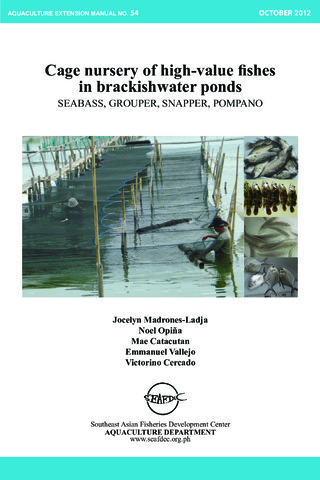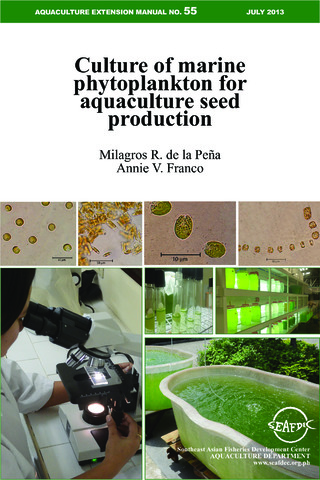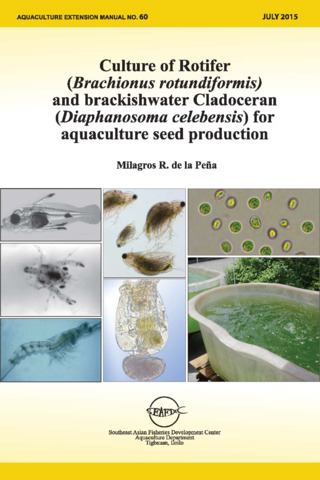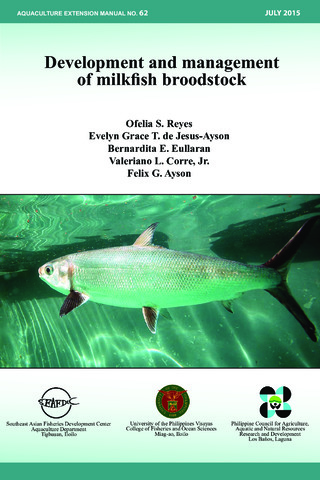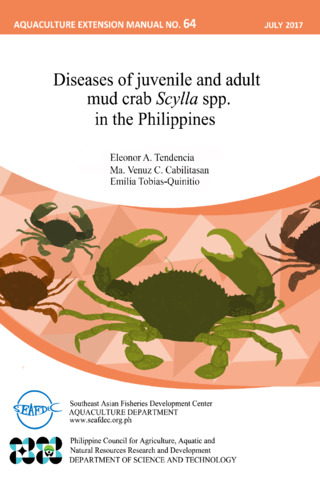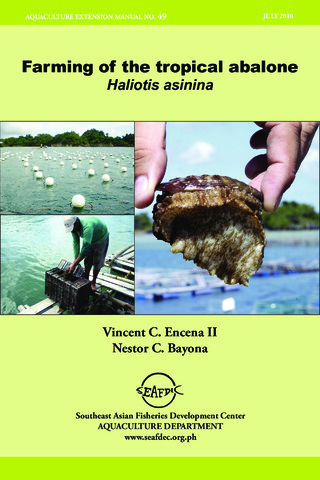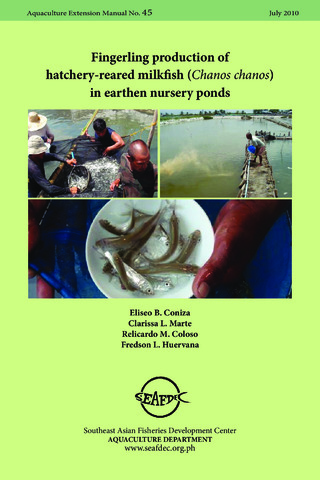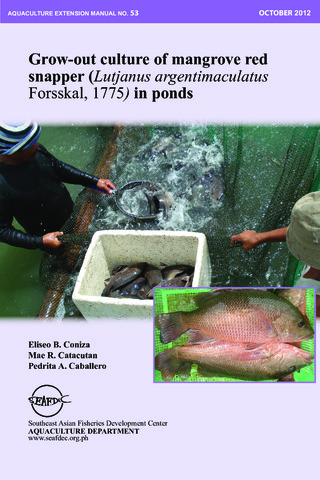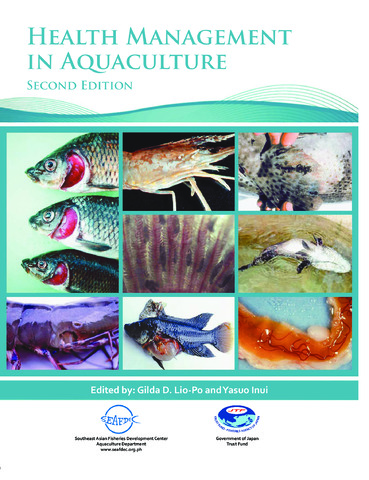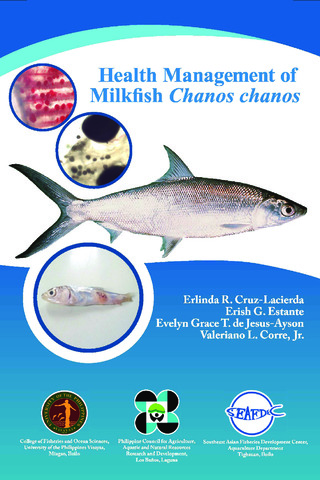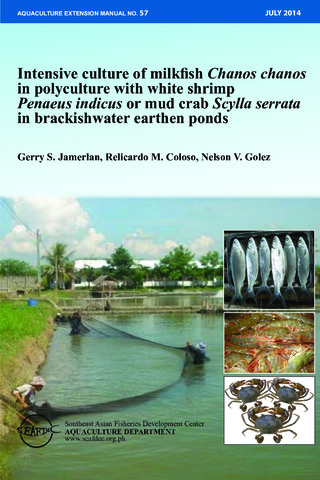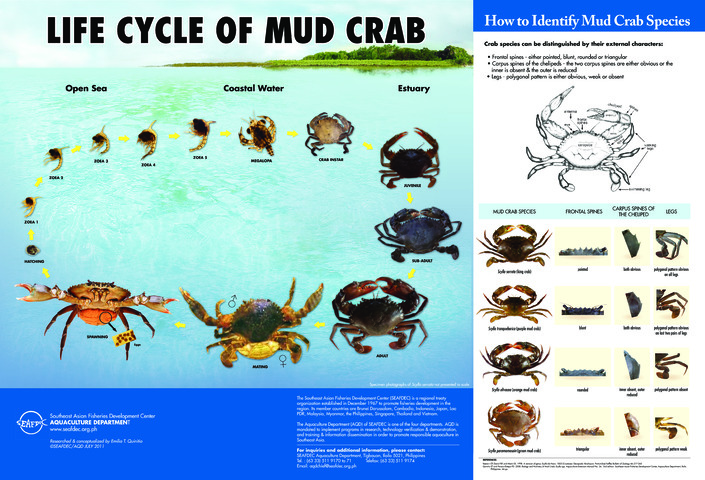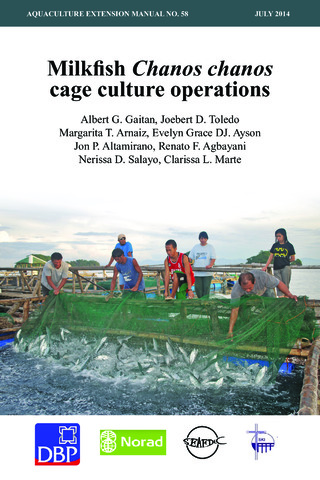Browsing SEAFDEC/AQD Publications in Print and for Sale by Title
Now showing items 1-20 of 31
-
Series: Aquaculture extension manual; No. 39
Abalone hatchery
(Aquaculture Department, Southeast Asian Fisheries Development Center, 2008)This manual contains information on abalone hatchery operation, including site selection, design, culture of natural food, broodstock management, spawning, nursery, packing and transport, and profitability analyses. -
Beach forest species and mangrove associates in the Philippines
(Aquaculture Department, Southeast Asian Fisheries Development Center, 2012)This new publication supported by UNESCO’s Man and Biosphere Programme introduces researchers and the general public to beach forest species and mangroves associates and describes their medicinal, traditional and commercial ... -
Series: Aquaculture extension manual; No. 34
Biology and hatchery of mangrove crabs Scylla spp.
(Aquaculture Department, Southeast Asian Fisheries Development Center, 2018)This manual includes the biology of crab (Scylla serrata, S. tranquebarica, and S. olivacea), and describes principles and procedures for spawning the mature crabs and rearing the zoea to ‘fly’ size crabs. It focuses on ... -
Series: Aquaculture extension manual; No. 54
Cage nursery of high-value fishes in brackishwater ponds: Seabass, grouper, snapper, pompano
(Aquaculture Department, Southeast Asian Fisheries Development Center, 2012)This extension manual describes nursery pond requirements, nursery rearing procedures, common diseases of young marine fish, and economic analysis of cage nursery as an enterprise separate from hatchery and grow-out culture. -
Series: Aquaculture extension manual; No. 55
Culture of marine phytoplankton for aquaculture seed production
(Aquaculture Department, Southeast Asian Fisheries Development Center, 2013)The 32-page extension manual describes the biology, culture techniques and maintenance and mass propagation of 12 phytoplankton species used as live feed in marine hatcheries. -
Series: Aquaculture extension manual; No. 60
Culture of rotifer (Brachionus rotundiformis) and brackishwater cladoceran (Diphanosoma celebensis) for aquaculture seed production
(Aquaculture Department, Southeast Asian Fisheries Development Center, 2015)A 32-page manual with topics on the biology and cultivation techniques of zooplankton. -
Series: Aquaculture extension manual; No. 62
Development and management of milkfish broodstock
(Aquaculture Department, Southeast Asian Fisheries Development Center, 2015)The manual provides developed and refined techniques for collection and transport of spawned eggs and larvae, as well as larval rearing. It also describes the necessary facilities for maintaining milkfish broodstock. Guidelines ... -
Series: Aquaculture extension manual; No. 64
Diseases of juvenile and adult mud crab Scylla spp. in the Philippines
(Aquaculture Department, Southeast Asian Fisheries Development Center, 2017)This manual aims to provide updated information on the diseases of mud crabs initially authored by Lavilla-Pitogo and dela Peña (2004). It includes the name of the disease, causative agent, stages affected, effects on mud ... -
Series: Aquaculture extension manual; No. 49
Farming of the tropical abalone Haliotis asinina
(Aquaculture Department, Southeast Asian Fisheries Development Center, 2010)This manual was written to provide abalone growers a practical guide on how to culture abalone based on the studies and trials conducted by SEAFDEC Aquaculture Department. -
Field guide to mangrove identification and community structure analysis
(Aquaculture Department, Southeast Asian Fisheries Development Center, 2013)The mangrove field guide is a 32-page field guide with a one page introduction on mangroves, followed by a key to mangrove genera and species (with colored pictures of the whole plant and plant parts), then a definition ... -
Series: Aquaculture extension manual No. 45
Fingerling production of hatchery-reared milkfish (Chanos chanos) in earthen nursery ponds
(Aquaculture Department, Southeast Asian Fisheries Development Center, 2010)Fingerling production of milkfish in ponds maybe operated as a commercial enterprise or a component of milkfish farming that comprises nursery, transition and rearing or grow-out phases. The fishpond nursery is used to ... -
Series: Aquaculture extension manual; No. 53
Grow-out culture of mangrove red snapper (Lutjanus argentimaculatus Forsskal, 1775) in ponds
(Aquaculture Department, Southeast Asian Fisheries Development Center, 2012)The mangrove red snapper is among the high-value marine fishes with great potential for export. Snapper is important to coastal fishery and ideal for aquaculture particularly in Southeast Asia. Grow-out culture of snapper ... -
Series: Aquaculture extension manual; No. 56
Hatchery production of snubnose pompano Trachinotus blochii Lacepede
(Aquaculture Department, Southeast Asian Fisheries Development Center, 2014)A 26-page extension manual describing the biology, broodstock acquisition & management, larval rearing, harvest & transport and prevention of diseases & parasites in hatchery production of pompano. -
Health management in aquaculture
(Aquaculture Department, Southeast Asian Fisheries Development Center, 2010-07)A textbook on diseases of cultured warmwater fish and shrimps in the Philippines. Eleven chapters cover essential information on the basic principles of disease causation, major diseases of cultured fish and crustaceans, ... -
Health management of milkfish Chanos chanos
(Aquaculture Department, Southeast Asian Fisheries Development Center, 2015-06)This monograph provides updated information on diseases of marine and brackishwater cultured milkfish in the Philippines. The information presented here is largely based on the results of a three-year research project on ... -
Series: Aquaculture extension manual; No. 57
Intensive culture of milkfish Chanos chanos in polyculture with white shrimp Penaeus indicus or mud crab Scylla serrata in brackishwater earthen ponds
(Aquaculture Department, Southeast Asian Fisheries Development Center, 2014)A 30-page extension manual describing the biology, site selection, pond management and harvest & post-harvest of milkfish intensive polyculture in earthen pond. -
Series: Aquaculture extension manual; No. 46
Intensive culture of sea bass, Lates calcarifer Bloch, in brackishwater earthen ponds
(Aquaculture Department, Southeast Asian Fisheries Development Center, 2010)An extension manual describing criteria for site selection, monoculture and polyculture operations including feeds and feeding, harvest, common diseases, economic analysis. -
Life cycle of mud crab
(Aquaculture Department, Southeast Asian Fisheries Development Center, 2011)Researched and conceptualized by Emilia T. Quinitio. -
The Malalison experience: empowering an island community in west central Philippines
(Aquaculture Department, Southeast Asian Fisheries Development Center, 2009)A 64-page booklet that describes SEAFDEC/AQD’s community fishery resources management project from 1991 to 1998 with a post project assessment in 2009. -
Series: Aquaculture extension manual; No. 58
Milkfish Chanos chanos cage culture operations
(Aquaculture Department, Southeast Asian Fisheries Development Center, 2014)A 42-pages extension manual describing the biology, fingerling production, site selection, cage design and construction, measurement & analysis of water & sediment quality parameters and economic analysis.



